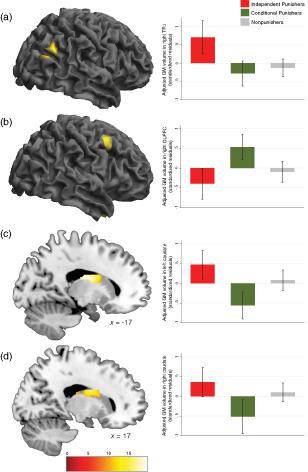当前位置:
X-MOL 学术
›
Hum. Brain Mapp.
›
论文详情
Our official English website, www.x-mol.net, welcomes your feedback! (Note: you will need to create a separate account there.)
Who initiates punishment, who joins punishment? Disentangling types of third-party punishers by neural traits
Human Brain Mapping ( IF 4.8 ) Pub Date : 2021-09-15 , DOI: 10.1002/hbm.25648 Thomas Baumgartner 1 , Jan Hausfeld 1, 2 , Miguel Dos Santos 1 , Daria Knoch 1
Human Brain Mapping ( IF 4.8 ) Pub Date : 2021-09-15 , DOI: 10.1002/hbm.25648 Thomas Baumgartner 1 , Jan Hausfeld 1, 2 , Miguel Dos Santos 1 , Daria Knoch 1
Affiliation

|
The act of punishing unfair behavior by unaffected observers (i.e., third-party punishment) is a crucial factor in the functioning of human societies. In everyday life, we see different types of individuals who punish. While some individuals initiate costly punishment against an unfair person independently of what other observers do (independent punishers), others condition their punishment engagement on the presence of another person who punishes (conditional punishers). Still others do not want to partake in any sort of punishment (nonpunishers). Although these distinct behavioral types have a divergent impact on human society, the sources of heterogeneity are poorly understood. We present novel laboratory evidence on the existence of these three types. We use anatomical brain characteristics in combination with stated motives to characterize these types. Findings revealed that independent punishers have larger gray matter volume in the right temporo-parietal junction compared to conditional punishers and nonpunishers, an area involved in social cognition. Conditional punishers are characterized by larger gray matter volume in the right dorsolateral prefrontal cortex, a brain area known to be involved in behavioral control and strategic reasoning, compared to independent punishers and nonpunishers. Finally, both independent punishers and nonpunishers are characterized by larger gray matter volume in an area involved in the processing of social and monetary rewards, that is, the bilateral caudate. By using a neural trait approach, we were able to differentiate these three types clearly based on their neural signatures, allowing us to shed light on the underlying psychological mechanisms.
中文翻译:

谁发起惩罚,谁参与惩罚?通过神经特征解开第三方惩罚者的类型
惩罚未受影响的观察者的不公平行为(即第三方惩罚)的行为是人类社会运作的关键因素。在日常生活中,我们会看到不同类型的人进行惩罚。虽然有些人独立于其他观察者的行为(独立惩罚者)对不公平的人发起代价高昂的惩罚,但另一些人则以另一个惩罚者的存在为条件(有条件的惩罚者)。还有一些人不想参加任何形式的惩罚(非惩罚者)。尽管这些不同的行为类型对人类社会有不同的影响,但人们对异质性的来源知之甚少。我们提出了关于这三种类型存在的新的实验室证据。我们使用解剖大脑特征与陈述的动机相结合来表征这些类型。研究结果表明,与有条件的惩罚者和非惩罚者相比,独立惩罚者在右侧颞顶叶交界处的灰质体积更大,这是一个涉及社会认知的区域。与独立的惩罚者和非惩罚者相比,有条件的惩罚者的特点是右背外侧前额叶皮层的灰质体积更大,这是一个已知参与行为控制和战略推理的大脑区域。最后,独立的惩罚者和非惩罚者的特点是在涉及社会和金钱奖励处理的区域(即双边尾状核)中的灰质体积较大。通过使用神经特征方法,
更新日期:2021-11-01
中文翻译:

谁发起惩罚,谁参与惩罚?通过神经特征解开第三方惩罚者的类型
惩罚未受影响的观察者的不公平行为(即第三方惩罚)的行为是人类社会运作的关键因素。在日常生活中,我们会看到不同类型的人进行惩罚。虽然有些人独立于其他观察者的行为(独立惩罚者)对不公平的人发起代价高昂的惩罚,但另一些人则以另一个惩罚者的存在为条件(有条件的惩罚者)。还有一些人不想参加任何形式的惩罚(非惩罚者)。尽管这些不同的行为类型对人类社会有不同的影响,但人们对异质性的来源知之甚少。我们提出了关于这三种类型存在的新的实验室证据。我们使用解剖大脑特征与陈述的动机相结合来表征这些类型。研究结果表明,与有条件的惩罚者和非惩罚者相比,独立惩罚者在右侧颞顶叶交界处的灰质体积更大,这是一个涉及社会认知的区域。与独立的惩罚者和非惩罚者相比,有条件的惩罚者的特点是右背外侧前额叶皮层的灰质体积更大,这是一个已知参与行为控制和战略推理的大脑区域。最后,独立的惩罚者和非惩罚者的特点是在涉及社会和金钱奖励处理的区域(即双边尾状核)中的灰质体积较大。通过使用神经特征方法,



























 京公网安备 11010802027423号
京公网安备 11010802027423号